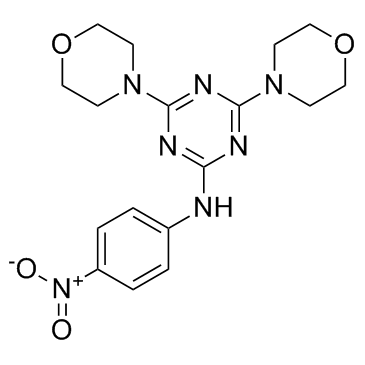| Description |
MHY1485 is a cell-permeable mTOR activator. MHY1485 has an inhibitory effect on the autophagic process by inhibition of fusion between autophagosomes and lysosomes.
|
| Related Catalog |
|
| Target |
mTORC1
mTORC2
Autophagy
|
| In Vitro |
MHY1485 induces mTOR activity, which is another regulator of autophagy. MHY1485 markedly increases the LC3II/LC3I ratio dose-dependently and time-dependently[1]. An mTOR activator MHY1485 stimulates mTOR, S6K1 and rpS6 phosphorylation. Treatment with MHY1485 increases phospho-mTOR levels without affecting total mTOR content. MHY1485 treatment also increases the phosphorylation of downstream S6K1 and rpS6 proteins without affecting total S6K1 and rpS6 levels[2]. An mTOR activator, MHY1485, also abolishes the inhibitory effect of liraglutide on osteoblastic differentiation, and results in p-mTOR and TGF-β downregulation, but does not attenuate the liraglutide-induced increase in p-AMPK protein expression levels. Co-treatment with 4 nM Liraglutide and 1 µM MHY1485, an mTOR activator, results in protein expression levels of Alp, OC, p-mTOR and TGF-β and matrix mineralization comparable to those of positive control cells cells[3]. MHY1485 treatment increases ribosomal protein S6 kinase (S6K) and eukaryotic translation initiation factor 4E-binding protein 1 (4E-BP1) phosphorylation, which are downstream targets of mTOR complex 1 (mTORC1), but decreases phosphorylation of Akt on mTOR complex 2 (mTORC2) target site serine 473[4].
|
| Kinase Assay |
Ovaries from mice at day10 of age are treated with 10 μM MHY1485 for 3h and proteins are extracted using M-PER Mammalian Protein Extraction Reagent containing a protease inhibitor cocktail. Protein concentrations in supernatants are determined by the bicinchoninic acid method. Equal amounts of protein lysates are loaded on 4-12% NuPAGE Bis-Tris gels in MOPS buffer and transferred to 0.45 μM pore nitrocellulose membranes[2].
|
| Cell Assay |
MC3T3-E1 cells are maintained in Dulbecco's modified Eagle's medium (DMEM) supplemented with 10% fetal bovine serum (FBS), 100 U/mL penicillin and 100 mg/mL streptomycin at 37°C in a humidified atmosphere of 5% CO2. Having reached 70% confluence, the culture medium is switched to commercial osteogenic differentiation medium. MC3T3-E1 cells are cultured in the osteogenic differentiation medium for 14 days, following by culture in DMEM supplemented with varying concentrations of liraglutide (catalog no. HY-P0014; MedChem Express) for a further 14 days. MC3T3-E1 cells treated with 4 nM liraglutide are cultured in the presence or absence of Compound C or MHY1485. MC3T3-E1 cells maintained in DMEM for 28 days in the absence of any treatment are used as the negative control (NC); cells cultured in commercial osteogenic differentiation medium for 14 days and in DMEM without liraglutide for an additional 14 days are used as the positive control (PC)[3].
|
| References |
[1]. Choi YJ, et al. Inhibitory effect of mTOR activator MHY1485 on autophagy: suppression of lysosomal fusion. PLoS One. 2012;7(8):e43418. [2]. Cheng Y, et al. Promotion of Ovarian Follicle Growth following mTOR Activation: Synergistic Effects of AKT Stimulators. PLoS One. 2015 Feb 24;10(2):e0117769. [3]. Hu XK, et al. Liraglutide attenuates the osteoblastic differentiation of MC3T3 E1 cells by modulating AMPK/mTOR signaling. Mol Med Rep. 2016 Oct;14(4):3662-8. [4]. Rakhmanova V, et al. Inhibition of Mast Cell Function and Proliferation by mTOR Activator MHY1485. Immune Netw. 2018 Jun 4;18(3):e18.
|
